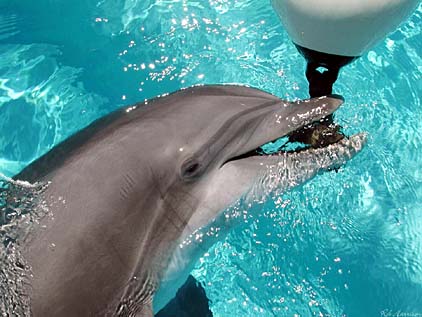
COURTESY OF THE KEWALO BASIN MARINE MAMMAL LABORATORY
Phoenix, shown here playing with a buoy that she loved pulling around her pool by its strap, died of cancer Jan. 10.
Researchers mourn
deaths of 2 dolphinsA lab hopes to use information
about the females' cancer
to treat other dolphins
The deaths of two of the three dolphins at the Kewalo Basin Marine Mammal Laboratory in under three months has left staff and students grief-stricken but they're continuing their programs.
"We are seeking to collaborate with other institutes to develop more extensive research programs that will utilize animals they have, as well as the animal we have, so we can jointly complete some interesting projects as we have in the past," said Louis Herman, who founded the Kewalo facility.
Herman brought female bottlenose dolphins Phoenix and Akeakamai to the laboratory 25 years ago from the Gulf of Mexico. Both died of cancer -- Phoenix on Jan. 10 and Akeakamai on Nov. 2.
"Ironically, they were in excellent health through almost all the 25 years except at the very end," Herman said.
When Phoenix began to show a loss of appetite, a series of tests was conducted and a telephone conference was held with about five veterinarians here and on the mainland, he said. Each had a complete medical history and records of the dolphin, but there was no consensus about her illness, he said.
However, an autopsy indicated Phoenix, like Akeakamai, died with cancer that had spread slowly from an oral tumor first diagnosed more than five years ago.
Herman said the same type of cancer has appeared in some dolphins in Florida and scientists and veterinarians are trying to learn more about it.
Studies of the two Hawaii dolphins and those in Florida may lead to a better understanding of the cause and treatment of the illness, which may also affect wild dolphins, he said.
The female dolphins and male Hiapo, about 17 or 18 years old, have illustrated in many studies at the Kewalo laboratory that dolphins have exceptional cognitive and communicative skills and sensory perception, Herman said.
"It has been an interesting collaboration during all this time between us and the dolphins. In every sense, it's a collaboration. You work with dolphins.
"They've given to the world so much information about what dolphins are capable of in terms of mental abilities and perceptual abilities. So their legacy will endure basically as long as there is marine science."
Herman said Hiapo is "in fine health, very vigorous. He's very sociable, just as they (the females) were ... He's responsive, a lot of fun to be with and, of course, very bright."
The lone dolphin "obviously is noticing there is a change," but the researchers are getting in the water and interacting and swimming with him, Herman said. "He makes his happy clicks when we get in, like a motor boat ... contentment clicks."
Herman said the laboratory will move forward with its educational activities, including some experience with the dolphin and lectures and presentations about marine mammals and conservation issues.
Outreach programs to public schools also will continue with presentations on whales and dolphins appropriate for different age groups, he said.
